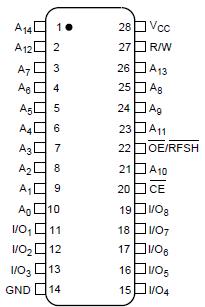Features: · 32,768×8 bit organization
· Access time: 100/120 ns (MAX.)
· Cycle time: 160/190 ns (MIN.)
· Power consumption:
Operating: 357.5/303 mW
Standby: 16.5 mW
· TTL compatible I/O
· 256 refresh cycle/4 ms
· Auto refresh is executed by internal counter (controlled by OE/RFSH pin)
· Self refresh is executed by internal timer
· Single +5 V power supply
· Packages:
28-pin, 600-mil DIP
28-pin, 300-mil SK-DIP
28-pin, 450-mil SOP
Pinout Specifications
Specifications
| PARAMETER |
SYMBOL |
RATING |
UNIT |
NOTE |
| Applied voltage on any pin |
VT |
1.0 to +7.0 |
V |
1 |
| Output short circuit current |
IO |
50 |
mA |
|
| Power dissipation |
PD |
600 |
mW |
|
| Operating temperature |
Topr |
0 to +70 |
|
|
| Storage temperature |
Tstg |
55 to +150 |
|
|
NOTE:
1. Referenced to GND
DescriptionThe LH5P832 is a 256K bit Pseudo-Static RAM organized as 32,768 ´ 8 bits. It is fabricated using silicon- gate CMOS process technology.
The LH5P832 uses convenient on-chip refresh circuitry with a DRAM memory cell for pseudo static operation. This simplifies external clock inputs, while providing the same simple, non-multiplexed pinout as industry standard SRAMs. Moreover, due to the functional similarities between PSRAMs and SRAMs, many 32K*8 SRAM sockets can be filled with the LH5P832 with little or no changes. The advantage is the cost savings realized with the lower cost PSRAM.
The LH5P832 PSRAM has the ability to fill the gap between DRAM and SRAM by offering low cost, low standby power, and a simple interface.
Three methods of refresh control are provided for maximum versatility. A 'CE-Only' refresh cycle refreshes the addressed row of memory cells transparently. All 256 rows must be refreshed or accessed every four milliseconds. 'Auto Refresh' automatically cycles through a different row on every OE/RFSH clock pulse, accomplishing the row refreshes without the need to supply row addresses externally. 'Self Refresh' further simplifies the refresh requirements by eliminating the need for address inputs and clock pulses entirely. An automatic timer senses time periods when memory accesses have ceased, and provides full refresh of all rows of memory without any external assistance.

 LH5P832 Data Sheet
LH5P832 Data Sheet







